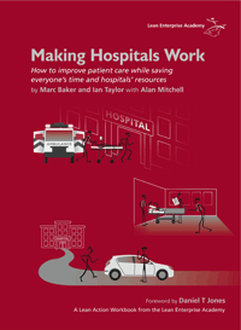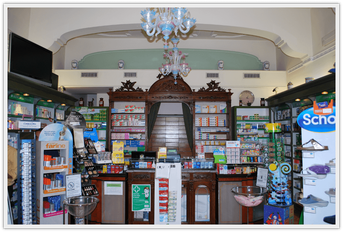|
How do patients give feedback on their experience in hospital or A+E?
0 Comments
 I'm reading a book at the moment. Actually its more of a manual than a book and it's called "Making Hospitals Work: How to improve patient care while saving everyone’s time and hospital’s resources". It tells the story of a fictional hospital and its new CEO. The CEO doesn't have any NHS experience but comes from an industry where they worship at the alter of "lean." The hospital in trouble. The CEO has been appointed by the board to turn the ship around. The troubles are not new or surprising. Patients waiting too long in A+E, delays to ward discharges, longer length of stay, medical patients on surgical wards, cancelled operations and so the list goes on. These are very familiar to anyone who has worked in the NHS. The manual tells the story of a the lean approach to assessing and making changes. Now I haven't finished the book but what strikes me so far in its analysis is the large amount of wasted time which occurs in the NHS. We are constantly waiting for things to happen, duplicating work (patients re-clerked and reviewed multiple times during admission) and dealing with huge amounts of apparent inefficiency. The book make you start to think about you own experiences and practice and here is an example. Its a Saturday afternoon and I happen to be in my office catching up on paperwork, The phone rings and the caller display flashes up a colleagues name. "I wonder if you can help us" he starts, "we have a patient where we suspect a pericardial effusion. The patient needs an echo, we tried to refer them elsewhere but there are some administrative difficulties." I stop him at that point because although they don't know I am in the hospital the decent thing is for me to just go to the ward and do the echo myself. This is good because it saves the patient being transferred and it gets the test done soon. Better patient care, consultant delivered, on the weekend - no argument with that. So I get the machine, go to the ward and do the echo. There is a large effusion - it needs to be drained. The patient is transferred to the coronary care unit and while this is happening I scurry round CCU to find all the bits of equipment I need. First a metal clinical trolley - I can't find the large one we usually use - no one has seen it. Then we find it acting as a stand for a "clinical wipe warmer". No I hadn't heard of that either but I guessing clinical wipes are a bit chilly on the skin so the patient experience is better if they are warmed before use. The pericardial drain set comes in a nice sterile pack with a bag and other bits and pieces so that is good but I also need other things. A sterile gown, sterile drapes, green needle, 50ml syringe, 10ml syringes, a silk straight needle suture, sample bottles, lignocaine and a dressing. I have to locate all of these items. There are spread throughout the ward in multiple locations - the clinical room, the sluice, the store room, trolleys on the ward, a hidden cupboard. It takes time, the Sister, feels sorry for me, helps but even she's not sure where some of the things are. We start talking. "Who is responsibility for stocking up?" I ask, "Well it's all of our responsibility" she says. "When the stock arrives who deals with it?" I ask, "Well whoever is on duty is supposed to put it away" she says. It's clear I know very little about how the ward actually operates but In my experience anything that is everyone's responsibility rapidly becomes no ones responsibility. It makes me see how the nurses must think of the doctors as a bit like guests in a hotel who visit for short periods, use the facilities but don't know anything about how the rooms get cleaned or the toiletries get replaced or how any of the supplies are ordered. I start to think about the lean manual I am reading and the what if questions begin? What if all the things I needed for my drain were in one clinical room? What if every clinical room on every medical ward in the hospital had the same layout with the same stock in the same places? What if the labelling systems were the same? What if there was a person who visited the ward twice a week to stock take, restock and organise these rooms? What if the stationary on the ward was in standardised cabinets so I didn't have to look though 3 filing cabinets to find the consent form. The amount of time wasted looking for things would be reduced. More time could be spent on direct patient care. I suspect that stock control on the wards is not as efficient as it should be and my what if might even save money by reducing the amount of waste and over-ordering. This isn't rocket science it's just common sense so why aren't we doing it?  Calcium channel blockers or CCBs such as amlodipine, diltiazem or verapamil are widely prescribed for the treatment of high blood pressure, angina and heart arrhythmias. Since these conditions make up a large part of a cardiologists workload most of us will have prescribed these medications to hundreds of people. Since the conditions they are used for are chronic patients are likely to be taking the medications for many years and this makes the long term safety of the medicines very important. Over the last 20 years there have been a number of scares about the safety of CCBs. In 1995 it was the association between increased risk of heart attack that made headlines such as "Drug for Blood Pressure Linked to Heart Attacks: Researchers Fear 6 Million Are Imperiled” and this generated considerable public concern. This scare came and went and the prescription of CCBs continued. Skip forward 18 years and now we have another scare - CCBs are associated with an increase risk of breast cancer. A paper in JAMA Internal Medicine released on the 5th August reports that long-term current use of CCBs is associated with an increased risk of breast cancer. Except that this is not a new scare as there have been rumblings about an association of CCBs with cancer for many years. In the late nineties two papers reported increases in risk of all cancers among elderly people but both studies were small and subsequent larger studies failed to confirm the CCB-cancer association. In 3 randomized clinical trials over 5 years no cancer signal was seen and after this the CCB-cancer hypothesis gradually faded away that is until just recently. So what does the current study show. There are two main types of invasive breast cancer - ductal and lobular. The researchers looked at women aged 55-74 years old. They took 1055 women with lobular and 905 women with ductal breast cancer type and compared then to 891 control women without a history of breast cancer. The control women were matched for age and other known risk factors for breast cancer. About half the women in each group had a history of high blood pressure and the researchers noted the type and duration of anti-hypertensive medication. In the control group 12 women had been taking a CCBs for more than 10 years. In the women with breast cancer 27 in the ductal group and 31 in the lobular group had been taking CCB for more than 10 years. In other words if you were a women with hypertension and breast cancer then you were more likely to be taking a CCB for 10 years or more. The results in the study are reported as odds ratios and this statistical measure gives an idea about the strength of association between the CCB exposure and breast cancer. When the authors looked at other blood pressure medication they did not find a significant association with increased risk of breast cancer. So essentially this studies shows a significant association between chronic CCB consumption and breast cancer risk but like all such studies it does not prove a causal relationship. So far so good but what women on CCBs and their doctors want to know is how much is the individual patient's risk of breast cancer is increased. This is where it gets more difficult, but not impossible. First you need to think about the women's baseline risk of breast cancer. There are web-base calculators which allow us to predicted this. The lifetime risk of developing breast cancer is 1 in 8 for a women in the UK. The average 60 year women has a risk of developing breast cancer of 1.8% over 5 years. From this and the odds ratio in the paper it is possible to estimate that 18 women need to be treated with a CCBs for 10 years in order to produce one additional case of breast cancer. We call that the number needed to harm and 18 is a fairly low number. To place this in context treating people with raised cholesterol with statins to prevent heart disease has a number needed to treat of about 50 and we regard this as effective treatment. So should we advise all our female patients who have been on CCBs for more than 10 years to stop taking them? Before we do this it is important to remember that the association with CCBs and breast cancer reported in this study were not seen when the same research group looked at a completely separate population of women. In their previous study they found that some other blood pressure tablets (thiazide and potassium-sparing diuretics) but not CCBs were associated with 40% and 60% increase in risk of breast cancer. In the California Teachers Study cohort they found that diuretic use for 10 years or longer was associated with a 16% increased risk, while use of CCBs and ACE inhibitors was not. A case-control analysis derived from the United Kingdom–based General Practice Research Database found no associations with use of ACE inhibitors, CCBs or β-blockers for 5 or more years. Confused? You should be. How can all these differences be explained since there appears to be no consistency. These studies are all conducted in different populations with different methodology, correction factors and time periods and so it is not surprising differences are seen. One very important point is that the recently published study only found an association between breast cancer and the use of the CCB in women treated for 10 years or more. It is possible that the effects of CCBs take many years to develop and since most of the previously published studies looked at shorter time periods the effect was missed. This new study has generated a lot of interest because CCBs are one of the most commonly prescribed class of drugs in the UK and breast cancer is the most commonly occurring cancer among women. If the CCBs do produce a 2-3 fold increase then long term CCB treatment would be a major modifiable risk factor for breast cancer. The results from this study are interesting and hypothesis generating. It is too early to recommend that all women who have been on CCBs for 9.9 years should be switched to alternative medications since the results from this study are not entirely consistent with other studies and need to be repeated and confirmed. However in the mean time cardiologists and GPs should be able to discuss the results of this study with patients and give appropriate advice perhaps by converting the odds ratios which are inherently difficult to understand into the number needed to harm. If an individual women has been on CCBs for a long time and is very anxious about continuing them then there are alternative treatments that can be offered and this should be discussed. Li et al., Use of Antihypertensive Medications and Breast Cancer Risk Among Women Aged 55 to 74 Years. JAMA Internal Medicine Odds ratio to NNT converter  Anyone who has been to Italy and needed to buy a medicine will have experienced the ‘farmacia’ or pharmacy. These shops, identified with the green cross symbol outside, give the impression of yesteryear. Enter and the farmacista, il dottore or la dotorressa will be wearing a white coat ready to greet you from behind a gleaming glass topped cabinet. Prego? This is your invitation to speak. If you want paracetamol you may well get a blank look, in Italy branded aspirin is the main painkiller of choice. If you want an alternative then there is the wonderfully named ‘Moment’ or ibuprofen. If you didn't have a headache when you arrived you certainly will when you are told the price. A small box of a dozen ibuprofen tablets will usually set you back around 8 to 9 Euro - an astonishing 60p per tablet. Shocked at the price you might think next time you can bypass the farmacia and get you medicine at the supermarket, think again. In Italy the farmacisti have a complete monopoly on the sale of medicines and until very recently medicines could only be sold in a designated farmacia. In 2006, in a feint nod towards the “free market” and following pressure from the Co-op, the government of Mario Monti passed a new law to allow the sale of some over the counter medicines in supermarkets. The Italian government was proud of the bill which was “rushed through” and became law in a record nine months! But wait for it, after intense lobbying, by guess who, it was agreed that there had to be a farmacista present at all times and the area where the medicines were sold had to be completely separate from the rest of the shop! Not surprisingly the status quo continues and there has been no change outside of very large supermarkets in big cities. Certainly there was of no benefit to the average Italian or the beleaguered tourist. When the new law was debated the main argument, proposed by the farmacisti, against the more liberal approach was that it would worsen the health of the population and thereby increase the burden on the already struggling Italian healthcare system. Cheap flights, budget airlines and the internet give the impression that the world is a smaller place but there are still huge cultural and practical differences between countries. Here in the UK it would be unthinkable to have to go to a pharmacy simply to buy a paracetamol, in Italy it is normal. We are familiar with self-treatment using simple medicines and the likelihood of harm is deemed to be low. Wide availability and competition has led to medicines being sold at incredibly low cost. To the outsider the Italian appears to be at the mercy of a cartel of farmacisti who must be raking in huge profits at the expense of a population with little choice about where to buy their medicines. But maybe the Italians’ don’t see it that way. Reading the press and blogs there isn’t a groundswell against this apparently anti-competitive practice. Perhaps some of this can be explained by the Italians deep respect for the professional. In Italy if you have a university degree you have a title. The farmacista is a dottoressa, the mechanic an engineer and even a football manager is a maestro. The farmacisti have a five years of university education followed by a tough national examination, they are organised and respected for their advice and experience. The ubiquitous white coat emphasises the idea of a clinical, scientific and laboratory approach – they are the medicine professionals and why wouldn’t want to buy your medicine from them? Surely it must be safer and if the medicines are only available a farmacia this re-enforces their special status and not something that can be picked up with alongside the groceries. Experiencing different cultures and systems is revealing. In Italy is the strength of the professional groups and the population trust of the professional which goes a long way to support this practice. My simple advice for the traveller is to take your own medicines with you and save yourself some money.  It usually goes like this. Mrs Jones is a lady in her mid-70s with a history of controlled hypertension. An irregular pulse is detected by a practice nurse usually during a routine blood pressure check. Atrial fibrillation is confirmed on an ECG and she is referred to cardiology outpatients. We go through the history, examination and then onto the management. I usually break this down into management of symptoms and reduction of stroke risk. In the asymptomatic patient the former is usually very easy so we rapidly move onto the latter which is usually more challenging. I explain that AF is associated with an increased risk of stroke. 10,000 people a year are admitted to hospital in the UK with a stroke and found to be in AF. Then we arrive at the moment of the consultation where the W word is mentioned. I have tried to introduce this gently using the word anticoagulation, talking about little clots in the heart, preventing them by thinning the blood but finally the W word has to come out: "So Mrs Jones I would recommend that we start you on Warfarin." A moment later the patient looks crestfallen. The reply is usually a combination of 1) I don’t want to go onto warfarin; 2) I have a friend/relative/neighbour who is on it and they have had terrible trouble; 3) I was dreading you would say that; 4) Can’t I just continue with the aspirin after all that thins the blood too doesn’t it? 5) Can I leave it for now and take it if things get worse. I usually ask the patient “What is your biggest worry?” and often the reply is: “I don’t want to have stroke!” We are recommending more and more anticoagulation. The awareness of the increased stroke risk associated with AF is rising and there are comprehensive guidelines recommending anticoagulation which apply to ever increasing numbers of patients. Anticoagulation in AF is now regarded by the pharmaceutical industry as big business. This made me consider the risks and benefits of different types of stroke prevention therapy for AF. Guidelines have made this easy. Calculate the CHADS2 or CHADSVASC score of the patient and if it is more than 1 for CHADS2 or 2 for CHADSVASC then anticoagulation is recommended. You don’t need to know or think about the absolute risk numbers just a simple addition. The guideline tells you when to start anticoagulation and of course if you follow the guidelines you can’t be criticised. On the other hand if the patient has a stroke and you didn't recommend warfarin then that is not good. If the patient has a serious bleed due to the warfarin then you can’t be criticised for following the guidelines, can you? Sometimes it helpful to think about the actual numbers behind these guidelines to see exactly the benefits and risks of the different treatments. It is common to tell the patient that anticoagulation reduces risk of stroke by two thirds - impressive. Consider Mrs Jones, she has an annual estimated stroke risk of 4.3% and an annual bleeding risk of 0.6% according to the risk calculators. Treating her with aspirin reduces the risk of stroke to 3.4% (22% RRR; 0.9% ARR, with a 1 in 106 chance of benefit per year). The risk of major bleeding rises to 1.1% (1 in 222 chance of being harmed). So a miniscule chance of benefit and miniscule chance of harm. Giving warfarin reduces stroke risk to 1.4% (66% RRR; 2.9% ARR, with a 1 in 35 chance of benefit per year) but the risk of major bleeding rises to 3.1% (1 in 40 chance of being harmed). If there are 1000 patients similar to this then by doing nothing 43 will have stroke and 6 of them a major bleed over the next year. Treat them all with warfarin prevents 29 strokes but cause 25 major bleeds. Treated them with aspirin prevents 9 strokes but cause 5 major bleeds. I guess it all depends on whether you fear stroke or bleeding more, major bleeding provided it is not cerebral haemorrhage is not usually associate with long term disability and so may be trying to compare apples with pears and remember the patients biggest fear was of having a stroke. The current recommendation is that anyone with a CHADS2VASC score of 2 or more should be offered anticoagulation. It is clear that warfarin treatment is associated with a benefit. As doctors we tend to emphasise the positives and stress the 66% risk reduction with warfarin compared to the 22% with aspirin. We do not stress the 5-fold increase in the risk of major bleeding associated with warfarin. There has been a huge interest in atrial fibrillation recently. Some of this has been driven by the availability of the new oral anticoagulant drugs and the intense advertising war between the different companies to position their drug as the most effective. This has also been accompanied by an awareness campaign to doctors regarding the stroke risk associated with atrial fibrillation as well as community clinics funded by the pharmaceutical industry intent on finding cases of atrial fibrillation and reviewing the anticoagulation treatment. As physicians we tend to play down the harmful effects of the treatments and emphasise the positives. We want to practice according to the guidelines. If you were the patient with AF and you were told you there was a 1:35 chance of benefit with warfarin and 1:40 chance of harm what would you do? |
Dr Richard BogleThe opinions expressed in this blog are strictly those of the author and should not be construed as the opinion or policy of my employers nor recommendations for your care or anyone else's. Always seek professional guidance instead. Archives
August 2023
Categories
All
|
 RSS Feed
RSS Feed

